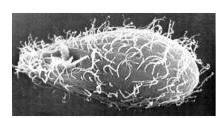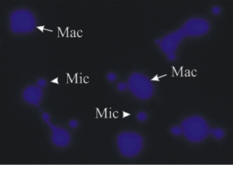

 Research in
the Price lab focuses on the structure of telomeres and how this
structure is maintained as cells divide. Telomeres are the protective
DNA-protein complexes that cap the ends of eukaryotic chromosomes. They
are essential for genome stability because they prevent end-to-end
fusion of chromosomes and facilitate the complete replication of the
terminal DNA sequences. Defects in telomere maintenance and/or telomere
structure lead to chromosome shortening and chromosome fusions. In
humans, abnormal maintenance of telomere length causes cells to become
immortal and hence is a key step in the development of many different
cancers.
Research in
the Price lab focuses on the structure of telomeres and how this
structure is maintained as cells divide. Telomeres are the protective
DNA-protein complexes that cap the ends of eukaryotic chromosomes. They
are essential for genome stability because they prevent end-to-end
fusion of chromosomes and facilitate the complete replication of the
terminal DNA sequences. Defects in telomere maintenance and/or telomere
structure lead to chromosome shortening and chromosome fusions. In
humans, abnormal maintenance of telomere length causes cells to become
immortal and hence is a key step in the development of many different
cancers.
Telomeres are composed of repeated sequence DNA and a series of unique telomere-binding proteins. The telomeric DNA usually consists of a short tandemly repeated sequence that is maintained by the enzyme telomerase. Telomerase is an unusual reverse transcriptase that copies an internal template RNA to add repeats onto the end of the 3’ strand. While most of the telomeric DNA is double-stranded, the 3' strand is extended to form a short overhang. Both the double and single-stranded regions of the telomeric DNA are packaged by telomere binding proteins to form a protective DNA-protein complex that acts as a cap for the end of the chromosome. This cap hides the DNA terminus from nucleases and DNA repair activities that would otherwise detect the DNA terminus as a double-strand break and promote chromosome fusions or signal cell-cycle arrest.
The Price
lab is studying the structure and composition
of the telomeric DNA-protein complex. We are particularly interested in the process of telomere replication. Replication of a telomere involves a number of steps beyond simple duplication of the double stranded DNA. These include processing of the DNA to generate the 3' G-strand overhang on each chromosome end, extension of the overhang by telomerase, and fill-in of the complementary C-strand by DNA polymerase alpha. We use both
 vertebrate cells and
ciliated protozoa
for our research because these two model systems are particularly well
suited for studying certain aspects of telomere biology.
vertebrate cells and
ciliated protozoa
for our research because these two model systems are particularly well
suited for studying certain aspects of telomere biology.

Ciliated protozoa are useful for studying telomere structure and function because they have literally thousands or millions of telomeres in each cell. This abundance of telomeres is why telomerase and telomere-binding proteins were first identified in ciliates. The Price lab is currently using the ciliate Tetrahymena thermophila to examine the steps involved in telomere replication and new telomere synthesis. We are particularly interested in the proteins that bind to the 3' overhang on the chromosome teminus. We are studying how they protect the DNA from unwanted DNA repair activities but yet allow access to telomerase and other replication factors.
Tetrahymena cells contain about 40,000 telomeres that consist of ~250 bp of T2G4 repeats. The large number of short telomeres has allowed us to develop procedures to analyze the terminal DNA structure at nucleotide resolution, something that is very difficult in other organisms. Tetrahymena cells also have excellent molecular genetics and the genome has been sequenced. As a result, it is relatively easy to generate mutant cell lines in order to determine how mutations in telomerase, nucleases or telomere proteins affect telomere length or the terminal DNA structure.
We previously identified a protein, Pot1a, which binds to the G-strand overhang. Pot1a is required to prevent the G-overhang from activating a catastrophic DnA damage checkpoint. It also regulates telomere length. We have recently identified two new proteins that interat with Pot1a: p61 and p45. p61 seems to act in conjunction with Pot1a to maintain the protective telomere cap structure that prevents recognition by DNA damage sensors. In contrast, p45 is needed for telomerase to act on the chromosome terminus. Disruption of the p45 gene causing progressive telomere shortening, a similar phenotype to that observed after disruption of telomerase. Interestingly, p45 does not seem to physically recruit telomerase to the telomere but may instead promote a conformational change in the telomere protein complex that allows telomerase to gain access to the DNA terminus. Future work will focus on the role of p61 and p45 in telomere replication and on the identification of other new telomere proteins.
An additional project is to determine the role of a Pot1 paralog, Pot1b, in new telomere synthesis. Pot1b is only 45% identical to Pot1a, and unlike Pot1a which is present at telomeres throughout the cell cycle, Pot1b is only made in recently mated cells that are making new teloemres. Currently it is unclear whether Pot1b is a telomere protein or a telomerase component.
The overall goal of this project is to understand how telomere proteins, DNA damage response and replication factors cooperate to replicate and protect telomeres. During S-phase, the telomere is transiently recognized as DNA damage and it recruits proteins such as ATM, ATR, MRN and the Rad9/Rad1/Hus1 checkpoint clamp. These damage response factors seem to play an important, but poorly understood role in telomere replication. Likewise, although the steps involved in telomere replication are well established, the mechanistic details are far from clear. Thus, we are seeking to define how four different types of ssDnA-binding protein cooperate during telomere replication. The proteins are (i) Pot1/Tpp1, an established telomere protein complex, (ii) the replication factor RPA, (iii) the Rad9/Rad1/Hus1 checkpoint clamp, (iv)the newly identified CST complex.
CST is a three protein complex composed of CTC1, Stn1 and Ten1 that is comparable to the Cdc13/Stn1/Ten1 (CST) complex from budding yeast. We have recently shown that CST is needed for telomere maintenance in mammalian cells, with depletion of CTC1 leading to elongated G-overhangs, a DNA damage response and increased telomere loss. Mammalian CST interacts iwth DNA polymerase alpha so it is likely to function in a similar manner to the budding yeast complex. Yeast CST couples synthesis of the telomeric G-strand by telomerase to C-strand synthesis by DNA polymerase alpha.
Our vertebrate telomere project involves a combination of genetic and biochemical approaches. Some of the work is done in mammalian cells or with mammalian protein while the genetic studies are performed with the chicken DT40 cell line. DT40 cells exhibit high levels of homologous recombination so it is relatively easy to generate both knock-out and knock-in cell lines that have mutant or tagged versions of the protein expressed at endogenous levels.
Home | Research | Curriculum Vitae | Recent Publications | Current Members
Past Members | Contact Information | Cancer and Cell Biology | Local Links